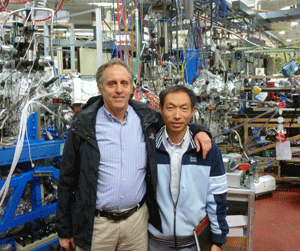 Steve Harris has worked for U.S. auto manufacturers for the past 30 years as a research scientist, testing and investigating various promising materials and technologies. As a result, Harris knows a thing or two about what the industry values. Harris is now at the ALS as a visiting scientist, sharing his insight and knowledge with ALS staff scientists working on battery research. Their results could help drive the future of battery-powered transportation in this country.
Steve Harris has worked for U.S. auto manufacturers for the past 30 years as a research scientist, testing and investigating various promising materials and technologies. As a result, Harris knows a thing or two about what the industry values. Harris is now at the ALS as a visiting scientist, sharing his insight and knowledge with ALS staff scientists working on battery research. Their results could help drive the future of battery-powered transportation in this country.
“If you are a national lab and you want to work on a project that’s going to get funded by industry, it has to be one with a clear, well-defined path to profit,” says Harris. “It’s key to know what the companies really need and who can tell you that.”
For Wanli Yang, an ALS staff scientist working on battery research, Harris has proved an invaluable resource, getting involved with Yang’s research and helping him understand how it can be applied to problems and questions relevant to the auto industry.
“There is a missing link between our academic society, especially for a user facility like the ALS, and industry,” says Yang. “I benefitted a lot by talking with Steve because he had an understanding of the true concerns of industry.”

Yang and Harris are currently researching the solid electrolyte interphase (SEI) layer in manganese-based Li-ion batteries, a new type of battery favored by the auto industry because it is safer and ultimately less expensive to produce than the more prevalent cobalt-based batteries. Harris and Yang believe that the SEI layer is involved in how manganese batteries decay – they plan to study the decay process with soft x-ray beamlines and watch how the manganese affects degradation. If they can decipher the relationship between Manganese and battery failure, it will give car manufacturers invaluable help in improving the lifetime of the batteries.
“Here at the ALS, we are very capable of doing this type of research,” says Yang. “But we wouldn’t have known that the industry wanted this type of information without input from Steve [Harris].”
Harris started researching batteries for the auto industry about five years ago. Working for General Motors (GM) at the time, Harris started a battery research program in battery degradation for the company. It turns out his timing was good, as shortly thereafter Obama came into office and launched a battery research funding program—the government announced it was going to put several billion dollars into battery R&D.
“Four years ago the government had all this money to give away and there weren’t enough good programs to take it,” says Harris. “Most U.S. companies had abandoned battery research in the previous decade. They ended up giving billions to battery companies to build manufacturing facilities in the US.”
The idea was that the U.S. would develop a new high-tech industry—battery manufacturing, research and development—but battery technology leadership still resides in Asia, says Harris.
Many national labs have jumped in with their own battery research programs and developed relationships with the auto industry in order to craft programs that deliver what the industry really needs. With most companies drastically cutting back on their in-house R&D labs, industry is outsourcing more and more to universities and national labs. This makes relationships like that of Harris and Yang’s even more valuable as the world of industry and science come together to address research challenges.
Image of battery-powered car courtesy of Tesla.